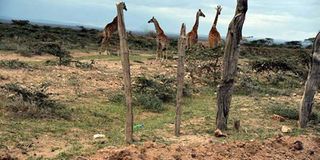Hundreds in Kieni to be evicted to allow wildlife movement

Giraffes stranded in Narok after encountering fences erected along a wildlife migratory corridor. Families living along wildlife migratory routes between Mt Kenya and Aberdare forests will have to move after KWS unveiled plans to re-establish the corridors. PHOTO | FILE | NATION MEDIA GROUP
What you need to know:
- KWS intends to zone out a 1km to 2km route along the over 50-kilometre stretch between Mt Kenya and the Aberdares.
- For KWS to acquire the land, it will have to compensate the owners or give them alternative portions elsewhere.
- Studies have shown that elephants will keep a memory of their migration route and stick to it for generations.
Families living along the wildlife migratory routes between Mt Kenya and Aberdare forests will have to move after the Kenya Wildlife Service (KWS) unveiled plans to re-establish the corridors.
The agency aims to control human-wildlife conflict in the Kieni plains in Nyeri by fencing off the migratory routes which were encroached by human settlements.
According to KWS, the migration corridor for wildlife has already been identified and talks will be initiated with the communities on the exercise.
KWS spokesman Paul Gathitu says the exercise is expected to start by the end of the year.
POPULATION HIGH
“The route has already been identified and we are very clear on the area. We understand that the population is high but it is important to re-establish the corridors,” Mr Gathitu.
KWS intends to zone out a route between one and two kilometres wide along the over 50-kilometre stretch between Mt Kenya and the Aberdares.
This means that the agency will have to acquire more than 12,000 acres of land for the corridor. The section will then be fenced off to allow the animals free passage as well as keep them off people’s farms and homes.
However, KWS agrees it is not going to be an easy task as they will have to convince the locals to give up their land to facilitate the exercise.
COMPENSATION
For KWS to acquire the land, it will have to compensate the owners or give them alternative portions elsewhere, a move that is expected to face resistance from some people.
An assessment on the procedure for the relocation and compensation is currently being done by KWS.
“It is not going to be easy. This means we will have to go into deep details on the discussion with local leaders and communities on compensations. But once they understand that these routes are instinctively built [by] the elephants they will agree,” the KWS spokesman explained.
DESTRUCTIONS
Over the years, encounters with wildlife has been a common problem for the residents of the area who have suffered millions of shillings in losses through destruction of property by wild animals.
For the Kieni residents, the biggest problem has been elephants which have stuck to the same migratory routes for decades.
And even though the jumbos have been destroying crops and causing human casualties, experts have blamed residents for encroaching on their space.
Studies have shown that elephants will keep a memory of their migration route and stick to it for generations.
ELEPHANT ROUTES
“Elephants are very specific of their migration routes and because of the settlement there is an impediment on how they move,” Mr Gathitu added.
Over the years, conservationists and KWS have made efforts to reduce human-wildlife conflict in the region by setting up sanctuaries and conservancies like the Solio Ranch and even though they have made progress, migration seasons are always a challenge.
For KWS, the move to reclaim the corridors not only protects human lives and also wildlife, but it will go a long way to bring down operational costs of translocating and controlling wild animals and compensation to residents for damages.
Just this year alone, KWS has translocated 21 elephants from the area, a pride of five lions and a leopard.
JUMBOS MOVED
The herd of 21 jumbos were moved in February from Solio to Tsavo following human-wildlife conflicts.
Rangers have also had to continuously drive away elephants from farms in the past weeks.
Two weeks ago KWS had to use a helicopter to capture five lions which had strayed into a resort in Naromoru.
The lions had killed several horses, livestock, a zebra and gazelle in the resort.
The lions were moved to Meru National Park.
Last month, a leopard was captured at Graceland Secondary School in Chaka and moved to Mt Kenya Forest.
COSTLY
According to KWS, capturing and moving these animals is very costly besides compensating for damages.
By December 2017, KWS owed Sh4.8 billlion in compensation resulting from human-wildlife encounters.
For an operation to translocate wild animals, KWS has to deploy dozens of rangers and hire expensive specialised equipment like helicopters and trucks.
For instance, using a helicopter to locate and capture animals will cost the agency around $1,000 (Sh100,000).
“Remember these animals do not exactly want to be moved so they try to evade. They are very expensive exercises so if we can control their movement without disturbing their ecosystem it will bring costs down,” Mr Gathitu told the Nation.




